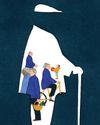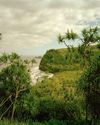
Above all else in the plant kingdom, trees make good trellises for our self-regarding thoughts. Robert Frost knew this when he wrote “Two roads diverged in a yellow wood.” A woodland is the right spot to yield to reflection. Though the life of a tree has little in common with the life of a person, we are accustomed to approaching trees on personal, even introspective, terms. As trunk is a synonym for torso, as branch can be interchangeable with limb, trees of great variety (especially the old ones) give body to human concerns.
Consider the coastal eucalyptus, forced by sea winds to grow prostrate along the ground—how the maxim “Better bend than break” takes shape in its supplicating posture. Or meditate on Sakura, the cherry blossom, and its instructive transience. We look to trees for their symbolism, and to have our own comparatively stunted existence put into perspective. High up in the Sierra Nevada mountains, bristlecone pines preside— seemingly more stone than wood, partly fossilized. Some rise from saplings at a tempo so slow that they endure through generations, even whole civilizations— thousands of years—living off the ephemeral sustenance that all trees rely on: light, water, a smattering of nutrients drawn from the soil. These ancient pines have been called sages and sentinels, as though it were their edict to stand watch over cycles of human progress and folly.
この記事は The Atlantic の July - August 2021 版に掲載されています。
7 日間の Magzter GOLD 無料トライアルを開始して、何千もの厳選されたプレミアム ストーリー、9,000 以上の雑誌や新聞にアクセスしてください。
すでに購読者です ? サインイン
この記事は The Atlantic の July - August 2021 版に掲載されています。
7 日間の Magzter GOLD 無料トライアルを開始して、何千もの厳選されたプレミアム ストーリー、9,000 以上の雑誌や新聞にアクセスしてください。
すでに購読者です? サインイン

JOE ROGAN IS THE MAINSTREAM MEDIA NOW
What happens when the outsiders seize the microphone?

MARAUDING NATION
In Trumps second term, the U.S. could become a global bully.

BOLEY RIDES AGAIN
America’s oldest Black rodeo is back.

THE GENDER WAR IS HERE
What women learned in 2024

THE END OF DEMOCRATIC DELUSIONS
The Trump Reaction and what comes next

The Longevity Revolution
We need to radically rethink what it means to be old.

Bob Dylan's Carnival Act
His identity was a performance. His writing was sleight of hand. He bamboozled his own audience.

I'm a Pizza Sicko
My quest to make the perfect pie

What Happens When You Lose Your Country?
In 1893, a U.S.-backed coup destroyed Hawai'i's sovereign government. Some Hawaiians want their nation back.

The Fraudulent Science of Success
Business schools are in the grips of a scandal that threatens to undermine their most influential research-and the credibility of an entire field.